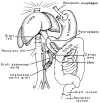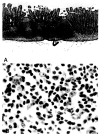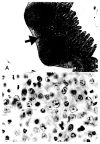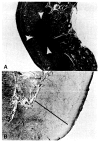Rejection of multivisceral allografts in rats: a sequential analysis with comparison to isolated orthotopic small-bowel and liver grafts
- PMID: 2237770
- PMCID: PMC3032401
Rejection of multivisceral allografts in rats: a sequential analysis with comparison to isolated orthotopic small-bowel and liver grafts
Abstract
Multivisceral isografts and allografts were transplanted to Lewis rats, and the histopathologic changes were studied in the liver, intestine, and other constituent organs. Rats receiving isografts had indefinite survival with maintenance of weight. With multivisceral allografts (from Brown-Norway donors), the intestinal component was rejected more severely than the companion liver and with about the same severity as when intestinal transplantation was performed alone. Intestinal rejection in either circumstance was a lethal event, causing death in 10 to 12 days. The earliest (by day 4) and most intense cellular rejection was in the Peyer's patches and mesenteric lymph nodes. This was associated with or followed by cryptitis, epithelial cell necrosis, focal abscess formation, mural necrosis, and eventual perforation. Liver allografts transplanted alone or as part of multivisceral grafts also had histopathologic evidence of rejection, but this was self-limiting and spontaneously reversible when the liver was transplanted alone. Thus the Achille's heel of multivisceral grafts is the intestinal component that is not protected by the presence of the liver in the organ complex. Better immunosuppression should permit successful experimental and clinical transplantation of such grafts.
Figures







References
-
- Williams JS, Sankary HN, Foster PF, Lowe J, Goldman GM. Splanchnic transplantation: an approach to the infant dependent on parentral nutrition who develops irreversible liver disease. JAMA. 1989;261:1458–62. - PubMed
-
- Kamada N. Experimental liver transplantation. 7-12. Boca Raton, FL: CRC Press; 1988. pp. 55–65.
Publication types
MeSH terms
Grants and funding
LinkOut - more resources
Full Text Sources
Medical
